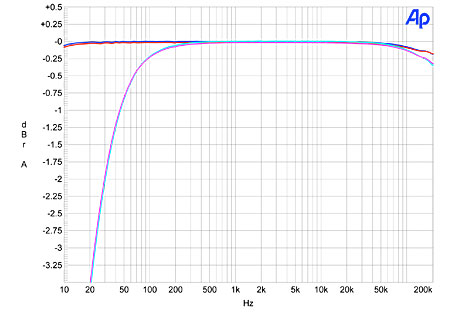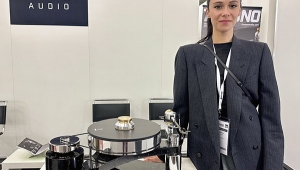| Columns Retired Columns & Blogs |
Convergent Audio Technology SL1 Renaissance preamplifier Measurements
Sidebar 3: Measurements
To examine the Convergent Audio Technology SL1 Renaissance preamplifier's measured performance, I primarily used Stereophile's loaner sample of the top-of-the-line Audio Precision SYS2722 system (see the January 2008 "As We See It" and www.ap.com).
Looking first at the SL1 Renaissance's phono stage, this offers 46.6dB gain in moving-magnet mode and 57.2dB gain in moving-coil mode, both figures assessed at the Tape outputs. The former is higher than the norm, the latter lower. Both phono stages preserved absolute polarity; ie, were non-inverting. The input impedances were 55k ohms at 1kHz for the MM input, dropping to 47k ohms at 20kHz; and for the MC input, 3560 ohms at 1kHz, dropping to 1270 ohms at 20kHz.
The SL1's RIAA correction (fig.1) was one of the most accurate I have measured, at less than ±0.05dB up to 10kHz. The MM input featured a slight rise above the audioband, the MC input a slightly early ultrasonic rolloff, reaching –3dB at 78kHz. Channel separation via the phono stage was good, at 61.5dB at middle and high frequencies, rising a little to 67.5dB at 20Hz. The unweighted, wideband noise floor of the phono stage was low via the MM input, at 67.6dB ref. 5mV at 1kHz, improving to 86dB when A-weighted. The MC input was less good, at 43dB ref. 500µV at 1kHz, due to the presence of some low-level 60Hz hum that I couldn't eliminate by experimenting with the grounding between the preamplifier and my test set. This improved to 58.3dB when A-weighted.

Fig.1 Convergent Audio Technology SL1 Renaissance, RIAA error for MM input (top traces) and MC input (bottom traces). (1dB/vertical div., right channel dashed.)
The SL1 Renaissance's phono-stage overload margin was the best I have seen. The MM input offered 33dB of margin at low and middle frequencies before the measured THD+noise reached 1%, dropping to 22.5dB at 20kHz, which is still excellent. The corresponding figures for the MC input were 42.2 and 31.6dB. To put this in perspective, the MC input overloaded with a 1kHz tone at 64.33mV, more than 42dB higher than the nominal 500µV reference level, with an output voltage at the Tape output of 46.4V! The minimum THD+N figure was just 0.0094%, illustrated graphically in fig.2, the spectrum of the SL1's output with the MM input fed a 1kHz tone at 50mV. The highest-level harmonic is the second, at –99dB, and the only other harmonic visible above the noise floor is the third, at –110dB! The SL1's phono stage is basically overload-proof.

Fig.2 Convergent Audio Technology SL1 Renaissance, MM input, spectrum of 1kHz sinewave at 50mV input, DC–10kHz, into 100k ohms (linear frequency scale; left channel blue, right red).
The CAT's line stage offered 15.0dB of gain when set to Low Gain, and 25.8dB set to High Gain. The input impedance was 45k ohms across the audioband under both conditions; the output impedance was 102 ohms at high and middle frequencies, rising to 475 ohms at 20Hz, due to the finite size of the output coupling capacitor. As a result, the preamp's output into the worst-case 600-ohm load rolls off prematurely at low frequencies, reaching –3dB at 22Hz (fig.3, cyan and magenta traces). Into the more realistic 100k ohm load, however, the response was flat to below 10Hz (fig.3, blue and red traces). At the other end of the spectrum, the output was maintained at full level almost to 100kHz. This graph was taken with the volume control set to its maximum; the preamp's bandwidth was not affected by either the Gain setting or the volume-control setting, which is commendable.

Fig.3 Convergent Audio Technology SL1 Renaissance, Low Gain, frequency response at 1V into 100k ohms (top two traces) and 600 ohms (bottom two traces) with volume control set to maximum (left channel blue, right red). (0.25dB/vertical div.)
Line-stage channel separation was superb at almost 100dB in both directions at 1kHz, but worse at higher frequencies due to the usual capacitive coupling between channels. It was still an excellent 70dB at 30kHz, however (fig.4). The wideband, unweighted signal/noise ratio (ref. 1V output with the input shorted but the volume control at its maximum) was 67.8dB in High Gain, 70.5dB in Low Gain. A-weighted, these figures improved to 91.3 and 96.4dB, respectively.

Fig.4 Convergent Audio Technology SL1 Renaissance, channel separation with High Gain (blue, red) and Low Gain (magenta, cyan). (L–R, blue & cyan; R–L, red & magenta; 10dB/vertical div.)
Fig.5 plots the THD+N percentage against output voltage into 100k, 10k, and 1k ohms. The downward slopes of the traces suggest that the actual distortion remains buried in the noise floor until the circuit actually starts to clip. (This graph was taken with the preamp set to High Gain; Low Gain was very similar.) The SL1 doesn't reach 1% THD until an extraordinary 48V into 100k ohms, and 39V was available into 10k ohms, which is about the lowest power-amplifier impedance the preamp will meet in practice. Even into 1000 ohms, the preamp doesn't clip until 6.9V, and at 2V into any of these loads—about the maximum level it will be asked to deliver—the distortion is buried under the noise.

Fig.5 Convergent Audio Technology SL1 Renaissance, High Gain, THD+N (%) vs 1kHz output level into (from bottom to top above 1V): 100k, 10k, 1k ohms.
I plotted the THD+N percentage against frequency at a relatively high level, 6V, into 100k ohms. Even so, the THD was very low over most of the audioband, rising only in the top two octaves (fig.6), and the only harmonics visible above the (low) background noise were the second and third (fig.7). However, at –111 and –126dB, respectively, these aren't going to bother anyone. Dropping the load impedance to 600 ohms, with a lower output level of 2V, introduced some higher-order harmonics (fig.8), but this is still good linearity overall. Finally, with its superb linearity, the SL1 Renaissance performed very well on the high-frequency intermodulation test (fig.9), with the difference signal into 100k ohms lying at –94dB (left) and –87dB (right).

Fig.6 Convergent Audio Technology SL1 Renaissance, Low Gain, THD+N (%) vs frequency at 6V into 100k ohms (left channel blue, right red).

Fig.7 Convergent Audio Technology SL1 Renaissance, High Gain, spectrum of 1kHz sinewave, DC–10kHz, at 6V into 100k ohms (linear frequency scale; left channel blue, right red).

Fig.8 Convergent Audio Technology SL1 Renaissance, High Gain, spectrum of 1kHz sinewave, DC–10kHz, at 2V into 600 ohms (linear frequency scale; left channel blue, right red).

Fig.9 Convergent Audio Technology SL1 Renaissance, High Gain, HF intermodulation spectrum, DC–24kHz, 19+20kHz at 6V peak into 100k ohms (linear frequency scale).
It may use tubes, but Convergent Audio Technology's SL1 Renaissance preamplifier offers superb measured performance and an equally superbly linear circuit topology. And its phono stage is bombproof.—John Atkinson
- Log in or register to post comments



































